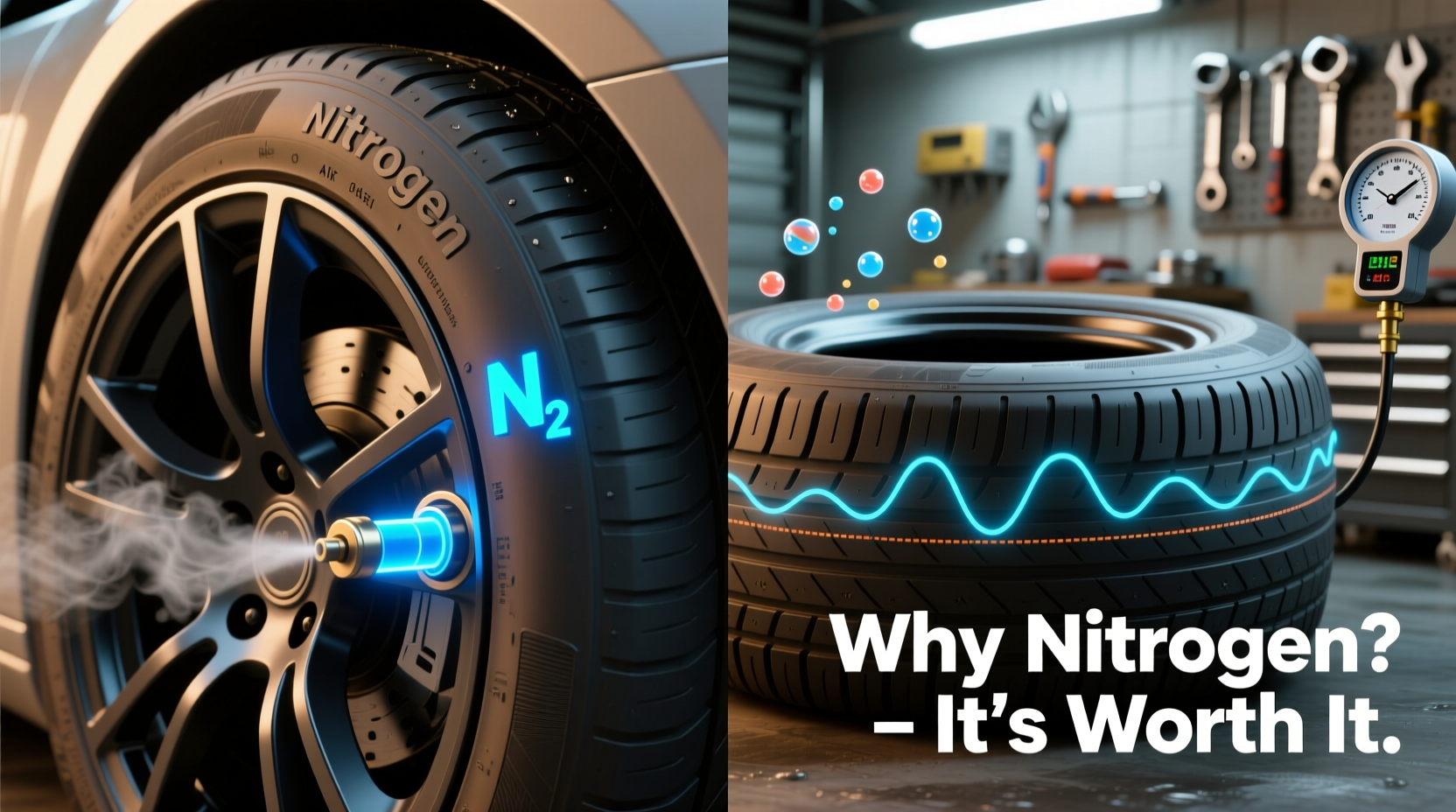For decades, compressed air has been the standard for inflating vehicle tires. But in recent years, nitrogen has emerged as a popular alternative—especially among performance drivers, aviation professionals, and fleet operators. Proponents claim that nitrogen improves fuel efficiency, extends tire life, and enhances safety. But how much of this is backed by science, and is it truly worth switching from regular air to nitrogen? This article dives deep into the chemistry, practical advantages, and economic realities of using nitrogen in tires.
The Science Behind Nitrogen Inflation

Air is composed of approximately 78% nitrogen, 21% oxygen, and 1% other gases, including water vapor and trace elements. When you fill your tires at a gas station, you're pumping in this ambient air—complete with moisture. Nitrogen, on the other hand, is a dry, inert gas. Pure nitrogen inflation typically uses a concentration of 93–95% nitrogen, significantly reducing oxygen and moisture content.
Moisture is the key issue. Water vapor expands and contracts more dramatically with temperature changes than dry gases do. In a tire, this can lead to inconsistent pressure fluctuations, especially under heavy use or extreme conditions. Nitrogen's larger molecules also permeate rubber more slowly than oxygen, which means tires maintain stable pressure longer.
“Tire pressure stability is one of the most underrated aspects of vehicle performance and safety. Nitrogen helps reduce variability caused by humidity and thermal cycling.” — Dr. Alan Richter, Automotive Materials Scientist
Benefits of Using Nitrogen in Tires
While nitrogen isn’t a magic solution, it does offer measurable advantages in specific scenarios:
- Improved Pressure Retention: Nitrogen leaks through tire walls about 30–40% slower than oxygen, helping maintain optimal PSI over time.
- Reduced Oxidation: Oxygen reacts with rubber compounds over time, leading to internal degradation. Less oxygen means less oxidation, potentially extending tire lifespan.
- Stable Performance in Temperature Extremes: Racers and commercial fleets benefit from predictable pressure behavior during rapid heating and cooling cycles.
- Less Corrosion in Rims: Moisture in compressed air can corrode aluminum and steel rims. Dry nitrogen mitigates this risk.
Is It Worth It? A Real-World Cost-Benefit Analysis
The average driver might wonder: Does the investment in nitrogen pay off?
For most daily commuters driving modern vehicles with Tire Pressure Monitoring Systems (TPMS), the benefits are marginal. Regular air, when checked and maintained properly, performs adequately. However, for certain users, nitrogen offers tangible returns.
Who Benefits Most from Nitrogen?
| User Type | Benefit Level | Reason |
|---|---|---|
| Fleet Operators | High | Consistent pressure reduces maintenance costs and downtime across large vehicle groups. |
| Race Car Drivers | High | Predictable pressure response under extreme heat improves handling and safety. |
| Aircraft & Heavy Equipment | Very High | Safety-critical systems require maximum pressure stability and fire resistance. |
| Daily Commuters | Low to Moderate | Only beneficial if tire maintenance is inconsistent; otherwise, minimal real-world gain. |
Mini Case Study: Regional Delivery Fleet
A mid-sized delivery company in Texas switched to nitrogen inflation across its 45-vehicle fleet. Over 18 months, they recorded a 12% reduction in tire replacements, a 3% improvement in average fuel economy, and fewer roadside service calls related to underinflation. While the initial setup cost $2,200 for equipment and training, the savings exceeded $6,000 annually. For them, nitrogen was not just worth it—it became a standard operating procedure.
Common Misconceptions About Nitrogen
Nitrogen inflation is often surrounded by marketing hype. Let’s clarify some myths:
- Myth: Nitrogen prevents blowouts.
Reality: While stable pressure reduces risk, blowouts are usually caused by impact damage, overloading, or severe underinflation—not gas type. - Myth: You never need to check nitrogen-filled tires.
Reality: All tires lose pressure. Nitrogen slows the process but doesn’t eliminate it. Monthly checks are still essential. - Myth: Only nitrogen-filled tires can be topped off with air in emergencies.
Reality: Yes, you can add regular air to a nitrogen-filled tire. It dilutes the purity but doesn’t cause harm.
Step-by-Step Guide to Switching to Nitrogen
If you’re considering making the switch, follow this process for best results:
- Check Current Tire Condition: Ensure tires are in good shape, without leaks or damage.
- Deflate Completely: Release all air from each tire to prepare for purging.
- Purge and Refill: Fill with nitrogen, then deflate again. Repeat 2–3 times to displace most oxygen and moisture.
- Inflate to Recommended PSI: Use a calibrated gauge and manufacturer’s specs.
- Label Valves (Optional): Use green caps to identify nitrogen-filled tires.
- Maintain Regularly: Check pressure monthly, even with nitrogen.
FAQ: Nitrogen in Tires
Can I mix air and nitrogen in my tires?
Yes. While mixing reduces nitrogen’s effectiveness, it’s safe and common. If you run low on the road, adding compressed air won’t damage your tires or rims.
How often should I refill nitrogen-filled tires?
Even with nitrogen, check pressure every month. Top-offs may be needed every 2–3 months depending on driving conditions and tire quality.
Does nitrogen improve fuel economy?
Indirectly, yes—but only if it helps maintain proper tire pressure. Underinflated tires increase rolling resistance, lowering fuel efficiency. Nitrogen supports consistent pressure, which can preserve optimal mileage.
Final Verdict: Is Nitrogen Worth It?
For high-performance applications, commercial fleets, or drivers in extreme climates, nitrogen inflation delivers measurable benefits in safety, efficiency, and tire longevity. The return on investment is clear when maintenance consistency and scale come into play.
For the average driver, however, the advantage is modest. With disciplined monthly pressure checks and quality tires, compressed air performs reliably. Nitrogen becomes a convenience rather than a necessity.
The real takeaway isn’t the gas—it’s the habit. Whether you use nitrogen or air, maintaining correct tire pressure is the single most impactful thing you can do for safety, fuel economy, and tire life.









 浙公网安备
33010002000092号
浙公网安备
33010002000092号 浙B2-20120091-4
浙B2-20120091-4
Comments
No comments yet. Why don't you start the discussion?